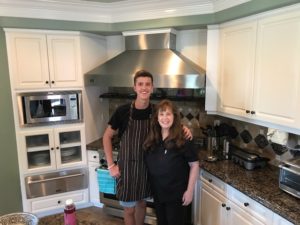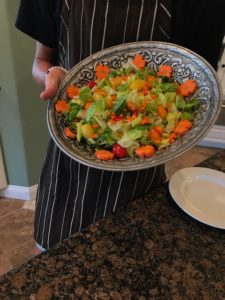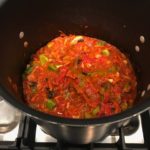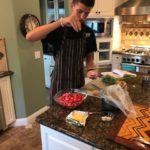
I am always training people how to cook and eat healthier. In the case of Training a Future Fire House Chef named Sam, it’s more of seeing how we can feed people for between $5.00 – $7.00 a meal. If I can come up with a few suggestions that come in at $5.00 my client will be a big time hero! And I’m all about creating heroes!
Our first class was about shopping. We went to the market so that he could learn how to pick fruits and vegetables at their best. I thought I would share some of the things he and I shared, plus give you a banging good Salad, Lasagna, Garlic Bread and Watermelon Dessert set of recipes and ideas.
Let me give you 3 things he learned:
- How to select onions, looking for less mold (black) on the outside and seeking a shape that is more pear like than flattened. You may see the flattened ones called Vadalia Onions. Those are great, but we are just talking about typical yellow onions. You are looking for onions with weight.
- Apples – The spots on apples (Fuji) are air holes and tastier if there are air holes. We tasted one side of the same apple. The red side was sweet and good. The yellow side was not. So the same apple can be both good and bad.

The trick to picking Apple - The difference between organic and not varies between .30 and .75 more for organic. Sam pointed out to me ‘that adds up if you are buying lots of ingredients’. And he’s right!
- Picking tomatoes and peppers – Firm unbruised
- Buying avocados – firm to the touch. You should be able to gently push in what is left of the stem. The flesh should give, slightly.
Kerrygold is great butter – superior flavor from Ireland. And since our Fireman is not plant based, we might as well steer him to the best!
In the kitchen he learned:
- If you cook onions with liquid fat coming from meat, they will steam and turn grey, never caramelize. Onions need to go into a flaming hot pan (hear the sizzle), then within minutes turn down to medium. Flip every 5 -10 minutes. The mistake people make is to continuously flip or stir it. Give it time to brown. Brown means flavor.
- You can get the bits on the bottom of your caramelized pan up into the mixture by adding liquid. If you use wine, the alcohol burns off. So you won’t be getting anyone drunk any time soon! lol
- When boiling pasta, salt the water like it’s the ocean (plentiful).
- How to Chiffonade. According to Wiki, Chiffonade is a slicing technique in which herbs or leafy green vegetables (such as spinach and basil) are cut into long, thin strips. This is accomplished by stacking leaves, rolling them tightly, then slicing the leaves perpendicular to the roll. I showed him how not to bruise the herb. Then Sam shows you (below) how to sprinkle it on, like a true chef!
- How not to cry cutting onions – put them into the freezer for 15-20 minutes before using.

Carrot Flowers - How to cut carrots into flowers – little Knicks in the sides can create beautiful artwork. Search on this blog for directions.
RECIPES
Sad but Simple Italian Dressing – We found this recipe to be too oily, the grate cheese to be too stringy even though grated through a fine box grater. I’m listing it here as a basis to experiment with.
3/4 C Olive Oil
1/4 C Red Wine Vinegar
1 garlic clove minced
1 Tblspn chopped fresh oregano
1 Tsp Kosher Salt
1/2 Tsp fresh ground black pepper
3 Tablspns grated Parmesan cheese
We used the basis of Alex Guarnaschelli’s Mother’s Marina Sauce as a base. It chocked full of vegetables including our beloved garlic.

For this recipe (after you are done reading this blog) please click on: RECIPE from the Food Network. We changed it up quite a bit, because I can never leave well enough alone…. lol substituting fresh tomatoes for canned (we scored and peeled them in boiling water and cold flashed them in a bowl gently lowered into an ice bath).
I must say I never do follow a recipe. I simply use it as a starting point.
For this one, we added caramelized onions, green pepper and mushrooms. All in all, our version was much chunkier even after I buzzed it with an immersion blender. And I wanted to show our fireman, who doesn’t eat onions or mushrooms, if he blends them into the sauce, he won’t notice he doesn’t like it. Instead he will see it adds flavor and nutrients. It was a teaching moment!
What we learned about Lasagne: First layer of pasta vertical, sauce then filling, then lay pasta horizontal, sauce then filling, last layer pasta is vertical, sauce then make sure your topping of meat and cheese plus sauce cover all the noodles (or the noodles will harden and burn in the oven). Filling can include ricotta cheese (flavored with salt, pepper and parmesan cheese), spinach, and a couple of pounds of meat – ground sausage, veal, turkey or beef. A combination of a few meats is better, but remember: less is more!
Roasting Garlic: Put the garlic in the oven on a rack with foil on the rack below it to catch whatever drops. 350 oven till garlic is soft (time depends on size of garlic and varies oven to oven).
Making Garlic Bread: Watch your bread in the oven after sliced thin at an angle. It burns quickly. After it is browned, you can rub garlic on it like butter, then add butter if you like and shred Parmesan on it. Place it under the broiler for another moment, and you have it. (For plant based use garlic and Earth Balance for the butter).

Making Basil Watermelon: Cut up your watermelon. Chiffonade your basil. Sprinkle on top for a delicious unexpected flavor.
This blog ran over and so did this cooking class! lol
We will be doing and documenting these weekly classes here. At the end of our course, Sam will earn Sous Chef Certification from Chef Marian Cooking Classes. If you are interested in doing the same please contact me at mm@chefmarian.com.
And please forward this to anyone new to cooking that may need this instruction.
Happy Healthy Eating,


 Your membership helps feed those in need through No Face Goes Unfed, bringing hope to San Diego and then nationwide.
Your membership helps feed those in need through No Face Goes Unfed, bringing hope to San Diego and then nationwide.
